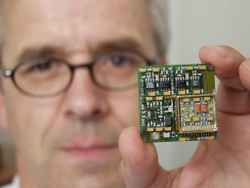
Posted to News on 27th Nov 2014, 15:06
Micro-Epsilon plays crucial role in Rosetta comet lander
Micro-Hybrid Electronic GmbH, a member of the Micro-Epsilon Group, has developed aerospace-grade sensor and evaluation electronics for scientific instruments installed on the Rosetta space probe's lander, Philae, which landed on the surface of the Churyumov-Gerasimenko comet on 12 November 2014.

Launched in 2004, the 1.3 billion Euro Rosetta project is an ESA (European Space Agency) mission with contributions from its member states and NASA. The box-shaped Philae lander, which weighs around 100kg, is equipped with a variety of scientific instruments whose function is to analyse the surface of the comet. Philae comprises of a baseplate, an instrument platform and a polygonal sandwich construction, all made from carbon fibre, as well as three unfolding legs for landing. Philae carries 10 instrument modules with a combined total mass of around 21kg.
One of these 10 instrument modules is APXS (Alpha Protons X-ray Spectrometer), whose function is to analyse the chemical composition of the surface of the comet. In order to investigate a particular material, the device bombards its surface with alpha particles and X-rays. By measuring the backscatter from the particles, scientists can deduce the chemical composition of the material and obtain information about the presence of the important elements carbon and oxygen.
The sensor evaluation and electronics for APXS were developed by Micro-Hybrid and certified for this particular mission by working in close collaboration with the Max Planck Institute in Mainz, Germany. In critical space applications such as this, no mistakes can be afforded and there are no second chances if components fail. Not only were the Micro-Hybrid electronics designed to withstand 10 arduous years of space flight time, they also needed to withstand the high impact shocks and vibrations resulting from landing on the rough terrain of the comet.
Following its 10-year flight time in space and subsequent landing on the comet, the full functionality of the APXS module was confirmed.
Karl-Heinz Suphan, Senior Project Manager R&D at Micro-Hybrid comments: "The components we've developed for the APXS instrument module need to withstand enormous levels of cosmic radiation and temperatures down to minus one hundred degrees Centigrade [-100degC]. Although the supply of high-performance, high-quality sensor evaluation and electronics is a common requirement for Micro-Hybrid, participating in such a high-profile, spectacular project like Rosetta is particularly exciting for us and demonstrates our technical expertise and leadership in our field."
Rosetta is the first mission in history to rendezvous with a comet, escort it as it orbits the Sun, and then deploy a lander to its surface. Based on data gathered from the comet's surface, scientists hope to discover more about how the Earth originally developed. The mission is expected to end in December 2015.
Micro-Hybrid also supplied sensor evaluation and electronics for the APXS instrument module on the successful NASA MER double mission to Mars in 2003.
For more information about aerospace-grade sensor and evaluation electronics go to www.micro-epsilon.co.uk.
No. 1 Shorelines Building
Shore Road
CH41 1AU
UNITED KINGDOM
+44 (0)151 355 6070






























